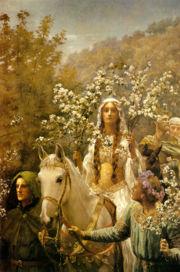|

According to Geoffrey of Monmouth Guinevere is descended from a noble family of Romans and is "the loveliest woman in
all the island". In later romances she is the daughter of Leodegrance, previous owner of the Round Table, which she brings,
together with one hundred knights, as her dowry when she marries Arthur. By the time of Chrétien de Troyes her affair with
Lancelot is well established - it is he, not Arthur, who rescues Guinevere from her abductor Méléagant. She is an accomplice
to Mordred's treachery against Arthur in the Vulgate cycle, a theme continued by Malory in Le Morte d'Arthur, where Queen
Guinevere's character comes to full fruition. Here, her lifelong relationship with Lancelot, who rescues her from being burnt
at the stake for adultery, eventually brings about the downfall of Camelot.

|
 |
 |
 |
 |
|
Le Morte d'Arthur: how King Arthur met and married Guinevere
This comes at the end of King Arthur's wars against the eleven kings. King Arthur and his two companion kings arrived
at Camelerd (Leodegrance's castle) with twenty thousand men, where they ream ten thousand of King Rience's men and put him
to flight, and rescued King Leodegrance.
This mid-paragraph sentence is all that Malory has to say about the initial attraction between Arthur and Guinevere -
'less is more', it seems, and nothing is said about Guinevere's feelings towards Arthur.
The first chapter of Book 3 is more expansive: 'How King Arthur took a wife, and wedded Guinever, daughter to Leodegrance,
king of the land of Camelerd, with whom he had the Round Table.' The role of Merlin the Wizard comes into play: Arthur says
to Merlin "My barons will let me have no rest, but needs I must take a wife, and I will none take but by thy counsel
and by thine advice."
"Is there any that ye love more than another?" enquires Merlin, to which Arthur replies "Yea, I love Guenever
the King's daughter Leodegrance, of the land of Camelerd, the which holdeth in his house the Table Round that ye told he had
of my father Uther. And this damosel is the most valiant and fairest lady that I know living, or yet that ever I could find."
At that point Merlin warns Arthur that Guinevere is not wholesome enough to be his wife, and that Lancelot would love
her (and she him). But Arthur's heart is set, and Merlin agrees to go to Camelerd to act as go-between. Leodegrance is overjoyed
and delivers his daughter, via Merlin, to London with the Round Table and "a hundred good knights".
The occasion of the marriage between King Arthur and Quinevere is interwoven with the ordination of the Knights of the
Round Table by the Bishop of Canterbury. The marriage ceremony itself is a strange affair, marked by the appearance of a white
hart that came running into the hall with a white brachet chasing after it, closely followed by sixty black hounds. As the
hart ran around the tables the brachet bit a piece out of its buttock, and it leaped into the air, unseating a knight from
his chair in the process. The knight got up, grabbed the brachet, and went out of the hall and rode away with it.
Three quests immediately follow, by the knights Sir Gawain, Sir Tor, and King Pellinor. When they return to Camelot -
with the marriage celebrations seemingly still under way - each reports to the king and queen, after which "all the knights
were sworn to the Round Table, and every year thereafter they would be so sworn at the high feast of Pentecost."
|
 |
 |
 |
|





